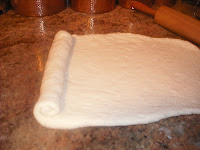So, if you've never baked bread. You're in for a one-of-a-kind experience. In the recipe for white bread below, I've tried to be as detailed as possible, hoping that anyone who has never baked a loaf will have no difficulty in doing so. My favorite Bread cookbook was given to me in 1995 by my sister, Dotty Ann. It's the very best gift and I've really gotten into baking a lot of bread because of it. It's called "The Book of Bread" by Judith and Evan Jones. (published in 1982 by Harper and Row) There are so many original and fabulous recipes in this book. So many breads from around the world--sweet breads, flat breads, fried breads, skillet breads, and much more! Another favorite Bread Cookbook is Peter Reinhart's "Brother Juniper's Bread Book" published by Addison-Wesley 1991. But my favorite white bread recipe is Chuck Williams' (Williams- Sonoma). Scroll down to view the recipe and directions.

This photo shows the beginning of the process. All the ingredients are in the bowl and ready to mix.
The next photo shows the process about 5 minutes into kneading. See how the dough is hanging onto the dough hook.That's a good sign.

The photo below shows the fully kneaded dough, formed into a tight ball and placed in oiled bowl.
This photo shows the dough has risen to twice its volume which took about 35 minutes. This is not the final rise!

In the photo below the dough has risen and is being rolled. Be sure to roll tightly, pressing out any air bubbles. Next are the shaped loaves ready for first rise in the oven (the oven is not lit, just the pilot light is on to create a warm environment for rising)

As you can see from the above photo, the loaves have risen to the tops of the pans.
SIMPLE WHITE BREAD
Chuck Williams @ WILLIAMS-SONOMA
Makes 2 Loaves
2 Tsp Sugar
4 Tsp Active Dry Yeast
2-1/2 Cups Water, (100-110 degrees)divided
2 Tsp Salt
6 Cups All Purpose White Flour
Dissolve the sugar and yeast in 1/2 Cup water in the bowl of a stand mixer. Or if not using mixer, in a large bowl. Let stand 5 minutes, till foamy, then add the remaining 2 cups of water, salt and all of the flour. Knead with the dough hook on speed 2 of a Kitchen Aid mixer for about 5 minutes. If mixing by hand, remove dough from bowl after you have combined the ingredients and knead on the counter top until dough is smooth and tacky, but not sticky (usually 5-10 minutes)
After you've baked a few loaves, you'll get the "feel" of it. I think the first time there's a tendency not to knead enough, so keep that in mind. You should kind of feel little bubbles popping under the surface. Anyway,when fully kneaded, form into a ball by gathering the edges and pulling them down and under and pinching where they come together at the bottom.
Again, you'll get a feel for this the more you handle dough. What you're doing is creating a "tight foundation" for the dough to rise from, otherwise it will spread out irregularly. Place the dough ball into an oiled bowl large enough to hold it when it expands to double its size. Cover loosely with plastic wrap or a cotton dishtowel and let it rest for 30-45 minutes or until double in size. I usually turn on the light in my oven without turning on the oven itself, and let the dough rise in there. It seems to be a perfect place without drafts and the light provides just the right amount of heat for rising.
After the dough has risen the first time, remove the covering and punch it down while still in the bowl (make a fist and push it down into the middle of the ball). Then form into a ball again, cover and let it rest in the same bowl for 30 more minutes or till double again; it may not take that long.
Finally remove the plastic, punch it again, reform and rest in the bowl for only 10 minutes.
On a floured surface, divide the dough in half and working with one half at a time, using a rolling pin, roll the dough into a rectangle that measures approximately 14" x 7". Starting with the 7" side, start rolling tightly and pressing out the air bubbles. Pinch the dough together to form a "seam" and place this side down for the bottom of the loaf. Pinch the ends of the loaf as well, and tuck them under.
Preheat the oven to 425 degrees.
Place seam side down in an oiled 9 x 5 loaf pan. Cover loosely with plastic and rest until doubled. Because the oven is heating, place the loaves in a draft free place for this final rise. This will take at the most 30 minutes. It's risen enough when it reaches the top of the loaf pan. At this point you can glaze the tops by lightly beating one egg and painting the top of the loaves.
Place the loaves in the preheated oven for 15 minutes. Then reduce the heat to 350 and bake about 15-20 minutes longer. Check by taking the loaf out of the pan and tapping the bottom. It should sound hollow.
Allow the bread to cool. I know, it will be hard to wait, but you must because the bread is still cooking in a sense. If you don't wait at least an hour all your time will have been wasted. Be patient. Slice or pull it apart and enjoy with butter or plain.




No comments:
Post a Comment